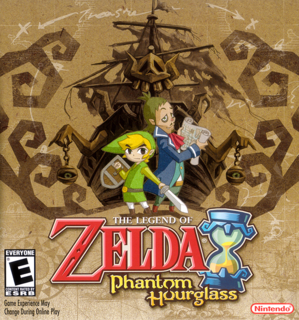Phantom Hourglass innovates the Zelda series with touch controls, but keeps to its roots.
The Legend of Zelda: Phantom Hourglass is a direct sequel to the Wind Waker. While sailing seas newly liberated from Ganondorf's wrath, Link and Tetra discover a ghost ship. Tetra, being the adventurous little tyke that she is, attempts to board the ship. Link attempts to save her, but falls into the ocean. He awakens on a strange island, meets a Navi-like fairy, and sets off to find his woman. Thus begins the Phantom Hourglass.
Phantom Hourglass plays most like the 2D installments in the series, using a top-down camera perspective. The catch here is that, being a game for the DS, it has the touch screen's capabilities at its disposal. Get this: the entire game is controlled using the touch screen. Not once will players ever have to touch the handheld's buttons (although, they are optional for opening the pause menu and using items). Every item has its own touch-based method of use. Swipe the stylus to swing Link's sword. Draw a line for a boomerang path. Tap enemies to plug them with arrows. The game also makes use of a memo system which allows players to scribble notes for themselves on the map. This comes in handy for solving puzzles, remembering the locations of key items, and more.
So what's the top screen used for? Various things. Most often it displays the dungeon map, which is self-explanatory. However, the map in Phantom Hourglass has the aforementioned memo system and also shows the location of Phantoms. What are Phantoms? They're just an integral part of the most annoying aspect in the entire game.
The Temple of the Ocean King is the central dungeon in Phantom Hourglass. At the beginning of the game, Link only has to traverse a few floors of it. As the game progresses, however, Link will have to adventure farther and farther into its depth, including previous floors already covered. Does that sound annoying? That's nothing yet. What's more, there's a time limit. This is where the game gets its namesake: the Phantom Hourglass is a time-keeping device that measures how long Link can stay alive while exploring the Temple. There are safe zones which temporarily stop the clock while occupied. The Phantoms are the guards of the Temple; if they catch Link, he gets sent back to the beginning of the floor and loses an extra minute off the clock.
The entire mechanic of the Temple is frustrating. Luckily, there's a halfway point that allows Link to start there every time he returns to the temple. When Link is exploring the rest of the world, things are as they should be. The regular dungeons have no time limit or phantoms, and play as any normal Zelda dungeons would. Collecting treasure, solving (elementary) puzzles, gaining new items, defeating boss monsters are standard Zelda fare. They all work incredibly well in Phantom Hourglass.
There's a good amount of items, although there aren't many new ones. Most of the items are the basic boomerang, bow-and-arrow, etc. seen in previous games. That's not really a complaint, however, as they're great fun to control with the touch screen.
Being the sequel the Legend of Zelda: The Wind Waker, one would expect some of the problems that plagued that game (few as there were) to be remedied, right? The main issue with that game was the sailing; the world was so large that sailing became monotonous after a while. The same holds true for Phantom Hourglass. The game world is incredibly large, but is comprised of ninety percent water. Islands are sparsely distributed, with leagues and leagues between each one. Sailing seems to drag on and on. It's automatic, however, as drawing a path for the boat makes it follow that path. But, the boat moves far too slowly. Fortunately, there is a warp system like in Wind Waker, but it only speeds things up a little.
As with any Zelda game, sidequests and mini-games are plentiful. Many islands are devoted solely to gaining additional treasure and customizable ship parts. There are plenty of treasure charts to find, which allow Link to dig for underwater treasure in a crane-game type mini-game.
Although not the first Zelda game to have multiplayer functionality, Phantom Hourglass executes it fairly well. Two players can go head-to-head, trying to collect as many force gems as possible. Additionally, this mode can be played over Nintendo Wi-Fi Connection, a first for the series.
Phantom Hourglass takes on a cel-shaded style like its predecessor. Despite the low resolution of the Nintendo DS's screens, the game looks great. It's very colorful, and it feels exactly like its GameCube counterpart. The music is very Zelda-like, but takes on the sea-faring mood of the Wind Waker. All the standard Zelda sound effects are in place.
Phantom Hourglass is undoubtedly a Zelda game in every way.

